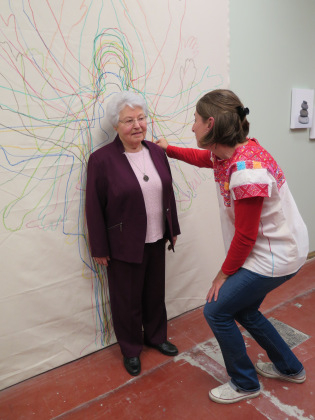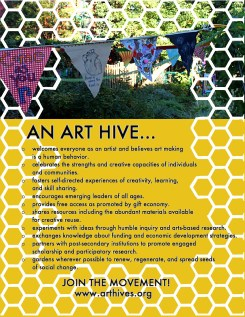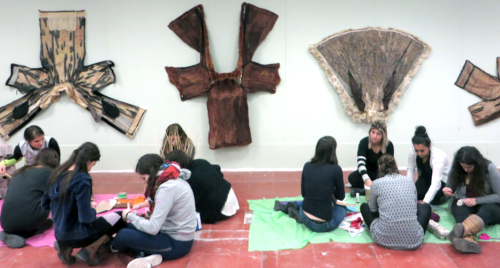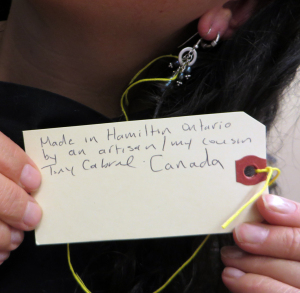 Maria Ezcurra (MFA, PhD), is an artist, educator, researcher and mother born in Argentina, raised in Mexico, and currently living in Montreal, Canada. She has participated in numerous exhibits worldwide, including the Montreal Museum of Fine Arts, the Museum of Modern Art in Mexico City, and the Nuit Blanche in Toronto. A recipient of many prestigious awards, including the Fulbright-Garcia Robles Scholarship and the FRQSC award, Maria is also a member of the National System of Art Creators in Mexico. She obtained a PhD at Concordia University with the first research-creation doctoral project presented in the Department of Art Education. Maria has worked as a teacher in a number of universities in Mexico and Canada over the past 15 years. She was one the first Artist-in-Residence at McGill’s Faculty of Education, where she is currently working as Art Facilitator at the McGill Art Hive Initiative and in the P. Lantz Artist-in-Residency Program. Her research interests include collaborative art practices, dress and textiles, gender-based violence, memory, identity and immigration.
Maria Ezcurra (MFA, PhD), is an artist, educator, researcher and mother born in Argentina, raised in Mexico, and currently living in Montreal, Canada. She has participated in numerous exhibits worldwide, including the Montreal Museum of Fine Arts, the Museum of Modern Art in Mexico City, and the Nuit Blanche in Toronto. A recipient of many prestigious awards, including the Fulbright-Garcia Robles Scholarship and the FRQSC award, Maria is also a member of the National System of Art Creators in Mexico. She obtained a PhD at Concordia University with the first research-creation doctoral project presented in the Department of Art Education. Maria has worked as a teacher in a number of universities in Mexico and Canada over the past 15 years. She was one the first Artist-in-Residence at McGill’s Faculty of Education, where she is currently working as Art Facilitator at the McGill Art Hive Initiative and in the P. Lantz Artist-in-Residency Program. Her research interests include collaborative art practices, dress and textiles, gender-based violence, memory, identity and immigration.

Altar for the Day of the Dead -Ofrenda de Día de Muertos-
To honour the lives of the children who did not return from Canada’s Indian residential schools
This altar (ofrenda) commemorates the lives of thousands of children who were taken from their homes and sent to Indian Residential schools and did not return home. The Truth and Reconciliation Commission has identified 3,200 deaths in the TRC’s Register of Confirmed Deaths, while other sources estimate that 6,000 children died in the Indian Residential schools. In over one-third of these deaths the schools did not record the children’s names, in one quarter of the deaths the child’s gender was not recorded, and in over half the cases the cause of death was not recorded. Children at Residential schools died at a far higher rate than school-aged children in the general population.
These findings are in keeping with statements that former students and their parents gave to the Commission. They spoke of children who went to school and never returned. The tragedy of the loss of children was compounded by the fact that burial places were distant or even unknown. Many Indigenous people have unanswered questions about what happened to their children or relatives while they were attending residential school.
The Day of the Dead (Día de Muertos) is a festive and sacred time in Mexico and some other Latin American countries. This day, the souls of the dead are welcomed back, joined with the living, becoming a celebration of life. Significant objects are placed as gifts to the visiting souls in ofrendas: the altars for the children are set on the eve of October 31st with sweets, fruits and white flowers, while the eve of November 1st is the time to honour the adults. Although many elements of Catholicism were incorporated into the ofrenda after the Spanish conquest, it is considered mostly an Indigenous tradition.
Read more…
As women artists we want to offer this ofrenda to the Indigenous children who never returned home – for whatever reason. Our hope is to promote awareness on this issue, creating a space for dialogue and bringing the community of McGill together.
With this ofrenda installed at the Faculty of Education, we want to acknowledge the traditional territory of the Kanien’kehá:ka people where we stand today, celebrating our ancestors and sharing diverse Indigenous culture with the community of McGill.
Project by Maria Ezcurra, Haidee Lefebvre and Lori Beavis, supported by the P. Lantz Initiative for Excellence in Education and the Arts, Institute for Human Development and Well-being (IHDW) and the McGill Art Hive Initiative (MAHI).
More pictures from this altar
Tree of Life





 Art Hive
Art Hive
Starting in September 2015, the Faculty of Education began hosting McGill’s first Art Hive (http://arthives.org) facilitated by AiR Maria Ezcurra on Wednesdays, from 10 am to 4 pm. Art materials and creative guidance were available to everyone who joined in to make art. It quickly became a space for getting together and create community through the arts. It was visited by 5 to 10 people per day, achieving a total of 250 visits in 9 months, including students, faculty, staff, and some external visitors.
Read more…
This "Manifesto" describes what the Art Hive was intended to be:
AN ART HIVE...
- welcomes everyone as an artist and believes art making is a human behavior
- celebrates the strengths and creative capacities of individuals and communities
- fosters self-directed experiences of creativity, learning, and skill sharing
- encourages emerging leaders of all ages
- provides free access as promoted by gift economy
- shares resources including the abundant materials available for creative reuse
- experiments with ideas through humble inquiry and arts-based research
- exchanges knowledge about funding and economic development strategies
- partners with post-secondary institutions to promote engaged scholarship and participatory research
- gardens wherever possible to renew, regenerate, and spread seeds of social change
Objectively Subjective
This participatory project represents the research and teaching practices of various DISE Faculty members. Related to visual and material culture, the series of images considers how objects influence our personal understanding of the world and shape our academic identities.
Creative Collaborations
Integrating the Arts into the Department of Integrated Studies in Education (DISE)
 See the ways that the Arts have been integrated into DISE classes through workshops organized by Artist in Residence Maria Ezcurra in collaboration with DISE instructors.
See the ways that the Arts have been integrated into DISE classes through workshops organized by Artist in Residence Maria Ezcurra in collaboration with DISE instructors.
Exquisite Corpse
Exercise to collaboratively explore the relationship between formal education and other kinds of local pedagogies and personal ways of knowing. Activity made with the Mentorship Program for the Mentees from the Kahnawake Survival School (KSS), in collaboration with the Social Equity and Diversity Education (SEDE), McGill.
Read more…
 Workshop for the Kindergarten Classroom: Loose Parts
Workshop for the Kindergarten Classroom: Loose Parts
Working with Sheryl Smith-Gilman’s students, we created an emblematic garden at one of the building’s walls using recycled and natural materials. We develop the materials together and explored visual ways of thinking and transmitting knowledge.
During the winter semester two sections of The Kindergarten Classroom participated in workshops with our artist in residence, Maria Ezcurra, at the Art Hive.
One of the course topics covered during the semester includes the theme of: Aesthetics and the Arts for Young Children. A “loose parts” workshop was organized in order for our pre-service teachers to experience open-ended materials and the provocation of the arts in consideration to children’s learning as a whole.
The participants engaged in artful play whereby materials and the environment were made available to be interpreted, and connected according to various provocations (e.g. sound, movement, design, connecting and disconnecting). Providing meaning to “loose parts” required students to consider the possibilities of how a child learns and ponders over the materials and environment he/she uses.
Each group of students involved themselves in concrete experiences using ‘loose parts”; an interactive and hands-on exploration that occurred naturally, as opposed to adult directed. It is in this free exploration and creation that adults can observe children’s concrete ways of thinking and doing, or as Erickson put it, adults can see the child’s “natural genius of childhood and their spirit of place” (Erickson, 1996, p.2).

Our “loose parts” workshop created endless possibilities and invited creativity. The workshop concluded whereby students reflected on their image of the young child. They transferred their considerations by creating a flower, or plant, to add to the visual garden on the first floor of the Education Building: A Kinder Garden!
Methods
 Math Methods Course
Math Methods Course
Mathematics Education students discuss with Artist in Residence Maria Ezcurra how mathematics can be understood and represented through art in relation to our daily lives, during their class with Professor Limin Jao.
 Mindy Carter’s Communication in Education Course: Looking at the environment as the 3rd teacher, students explored their surroundings to understand them in new ways, to perceive how they shape and are shaped by their learning experiences.
Mindy Carter’s Communication in Education Course: Looking at the environment as the 3rd teacher, students explored their surroundings to understand them in new ways, to perceive how they shape and are shaped by their learning experiences.
 Renee Jackson’s Art Class: We worked with the students’ clothes to talk about personal, social and cultural identities and their relation to production processes and consumer choices.
Renee Jackson’s Art Class: We worked with the students’ clothes to talk about personal, social and cultural identities and their relation to production processes and consumer choices.
 Chloe Garcia’s Communication in Education Course: Looking at the environment as the 3rd teacher, this activity encouraged students to be mindful and considerate to what is communicated in the physical classroom and how the classroom can act as third “teacher” in many ways.
Chloe Garcia’s Communication in Education Course: Looking at the environment as the 3rd teacher, this activity encouraged students to be mindful and considerate to what is communicated in the physical classroom and how the classroom can act as third “teacher” in many ways.
